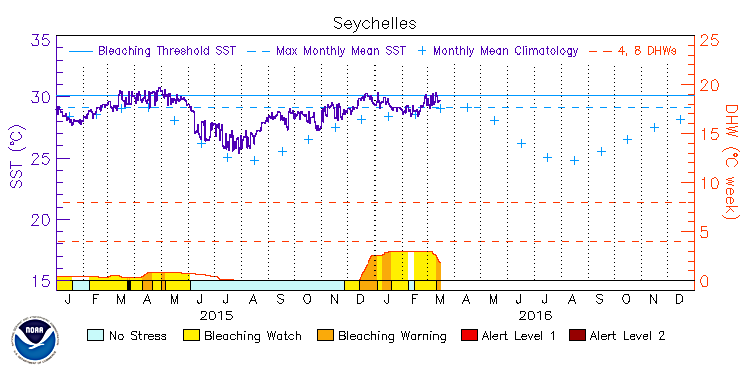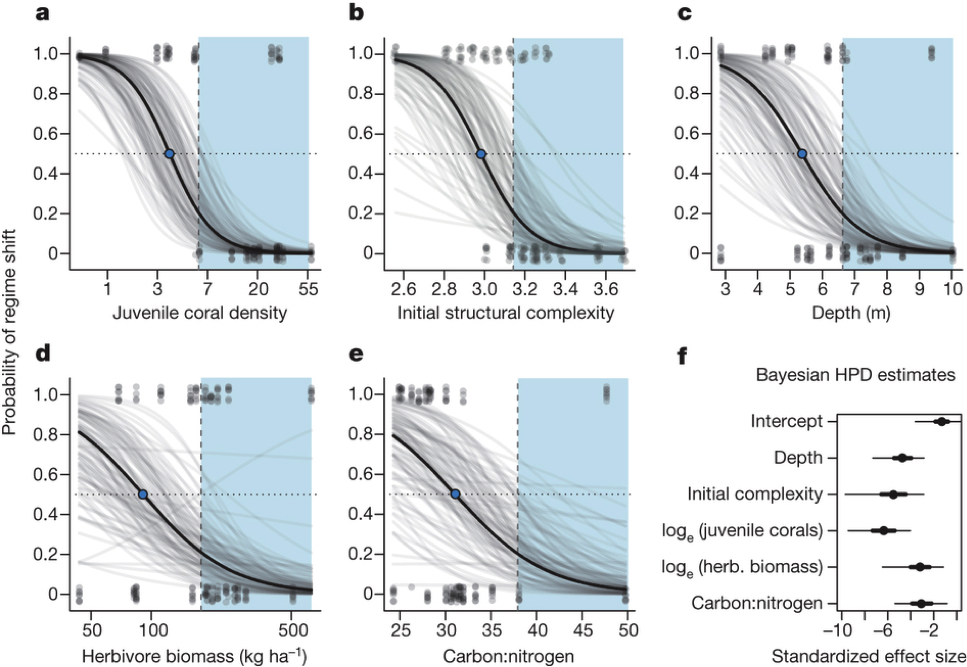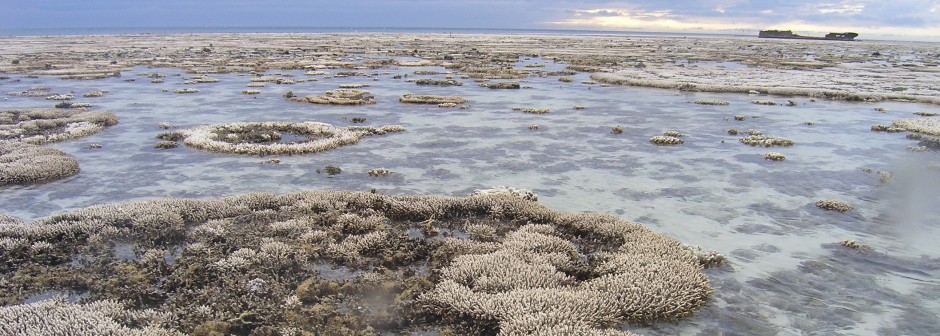Widespread bleaching has not yet affected the Seychelles in what is now a devastatingly long world bleaching event. The Seychelles is currently under a bleaching warning, but factors have not become extreme enough to issue an alert level 1 or 2 such as in eastern parts of the Indian Ocean (Figure 1).3 Mark Eakin, an oceanographer working for NOAA announced in February of 2016 that the likelihood of the bleaching event lasting into 2017 is high, so the Seychelles could still be impacted.1 The next question to ponder is how reefs will respond to this ecological devastation after the event is over. A look at recovery of reefs in the Seychelles after the 1998 bleaching event is possible thanks to a study conducted by Australian scientists.

Figure 1. “NOAA Satellite and Information Service” Sea surface temperature is graphed in purple at the top of the graph. The blue line represents the sea surface temperature at which reefs are in danger of bleaching. Degree heating weeks is expressed on the bottom part of the graph, which shows how much heat stress has accumulated. The Seychelles are experiencing a bleaching warning.
Nicholas Graham is a coral researcher at the renowned James Cook University in Australia and is the lead author in the study Predicting climate-driven regime shifts versus rebound potential in coral reefs published by Nature in February 2015. His research team assessed the shifts in ecosystem function on 21 reefs in the Seychelles using data from a 17-year long period.2 These reefs were surveyed in 1994, before the bleaching event of 1998 that wiped out over 90% of hard coral cover in the Seychelles, and again in 2005, 2008, and 2011, all using identical methods. Before the bleaching event of 1998, average hard coral cover across all reefs surveyed was marked at 28% and macroalgal cover was at 1%.2
Of the 21 reefs surveyed, 12 have recovered post-bleaching with an average hard coral cover of 23% across these sites and macroalgal cover less than 1% in 2011. In the other nine reefs, a shift regime occurred where macroalgal cover increased to 42% and coral cover remained below 3%.2 Since all of these reefs were similar in composition before the bleaching event, this new data is evidence that bleaching events can cause a shift in ecosystem dynamics that favor microalgae cover years after the event.2 Furthermore, the study also observed changes in the abundance of fish at the reefs and found that populations more or less recovered on the reefs that bounced back but that the abundance of fish was altered on the reefs dominated by fleshy algae.2

Figure 2. “Graham 2015” The black line represents the mean model fit. The blue dot indicates the point where a regime shift and recovery are equally likely. The grey dots indicate reefs that have recovered (0) and reefs that underwent a regime shift (1). The blue region represents the interval where a regime shift is decreasingly unlikely to occur.
This study also attempted to identify factors that would likely indicate whether a reef would recover or undergo a regime shift after a bleaching event. Reefs were more likely to recover if they had architectural complexity, were located in deeper waters that had low nutrient loads, and had an abundant population of fish and juvenile corals (Figure 2).2 This is crucial information to know for management and restoration efforts as these bleaching events are likely to become an increasing occurrence as ocean temperatures continue to warm. Check in next time to learn more about the fate of the Seychelles coral reefs.
- Gaworecki, Mike. “The longest coral bleaching event in history isn’t over yet.” Mongabay. 25 Feb 2016. Web. 16 Mar. 2016
- Graham et al Predicting climate-driven regime shifts versus rebound potential in coral reefs. Nature, (2015)
- “Western Indian Ocean 5-km Coral Bleaching Data Products.” Coral Reef Watch. NOAA Satellite and Information Service. Web. 16 Mar. 2016.

